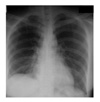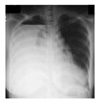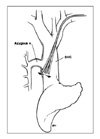Abstract
Central venous catheterization is used to provide a large amount of fluid, total parenteral nutrition and to administer antitumor agents with few complications reported. We report an uncommon case of pleural effusion that occurred after central venous catheterization. In many cases, the mechanism for the pleural effusion after central venous catheterization occurs through an injury to the superior vena cava by the continuous mechanical force of the catheter tip, the flow of large amount of fluid and an osmotic injury to the wall of the vein. This case is somewhat different in that the central catheter was placed in an aberrant vessel resulting in the pleural effusion. A post-placement chest roentgenogram and the correct approach of catheterization are important for preventing this complication.
Figures and Tables
Figure 1
Chest PA after central catheterization via internal jugular vein. The tip of catheter is placed inappropriately.

Figure 2
Chest PA shows massive hydropneumothorax. The tip of catheter is broken away from the former site.

References
1. Olivares Lopez A, Borras Rubio E, Sanchez Ortega JL, Fernandez Contreras R, Riquelme MR, Lopez Rodriguez F. Iatrogenic hydrothorax after catheterization of the left internal jugular vein. Rev Esp Anestesiol Reanim. 1991. 38:189–191.
2. Colon R, Frazier OH. Right hydrothorax after left subclavian and internal jugular vein catheterization: a delayed complication. Tex Heart Inst J. 1985. 12:389–392.
3. Paw HG. Bilateral pleural effusions: unexpected complication after left internal jugular venous catheterization for total parenteral nutrition. Br J Anaesth. 2002. 89:647–650.
4. Campagnutta E, Segatto A, Maesano A, Sopracordevole F, Visentin MC, Scarabelli C. Bilateral hydrothorax with hydromediastinum after cannulation of the left internal jugular vein. Minerva Ginecol. 1989. 41:479–483.
5. Tayama K, Inoue T, Yokoyama H, Yano T, Ichinose Y. Late development of hydrothorax induced by a central venous catheter: report of a case. Surg Today. 1996. 26:837–838.
6. Ishibashi H, Ohta K, Ochiai T, Kaisan T, Ishikawa T, Kubota T, et al. Delayed hydrothorax induced by a pericutaneous central venous catheter; report of a case. Kyobu Geka. 2002. 55:213–215.
7. McDonnell PJ, Qualman SJ, Hutchins GM. Bilateral hydrothorax as a life-threatening complication of central venous hyperalimentation. Surg Gynecol Obstet. 1984. 158:577–579.
8. Porcel JM. Unilateral pleural effusion secondary to brachiocephalic venous thrombosis: a rare complication of central vein catheterization. Respiration. 2002. 69:569.
9. Dhande V, Kattwinkel J, Alford B. Recurrent bilateral pleural effusions secondary to superior vena cava obstruction as a complication of central venous catheterization. Pediatrics. 1983. 72:109–113.
10. Currarino G. Migration of jugular or subclavian venous catheters into inferior tributaries of the brachiocephalic veins or into the azygos vein, with possible complications. Pediatr Radiol. 1996. 26:439–449.
11. Lee AC, Patel JV, Picton SV, Squire R. Internal thoracic vein cannulation as a complication of central venous catheter insertion. Med Pediatr Oncol. 2003. 40:195–196.
12. Jung KS. Mechanism of pleural effusion. Tuberc Respir Dis. 1999. 47:141–149.




 PDF
PDF ePub
ePub Citation
Citation Print
Print




 XML Download
XML Download